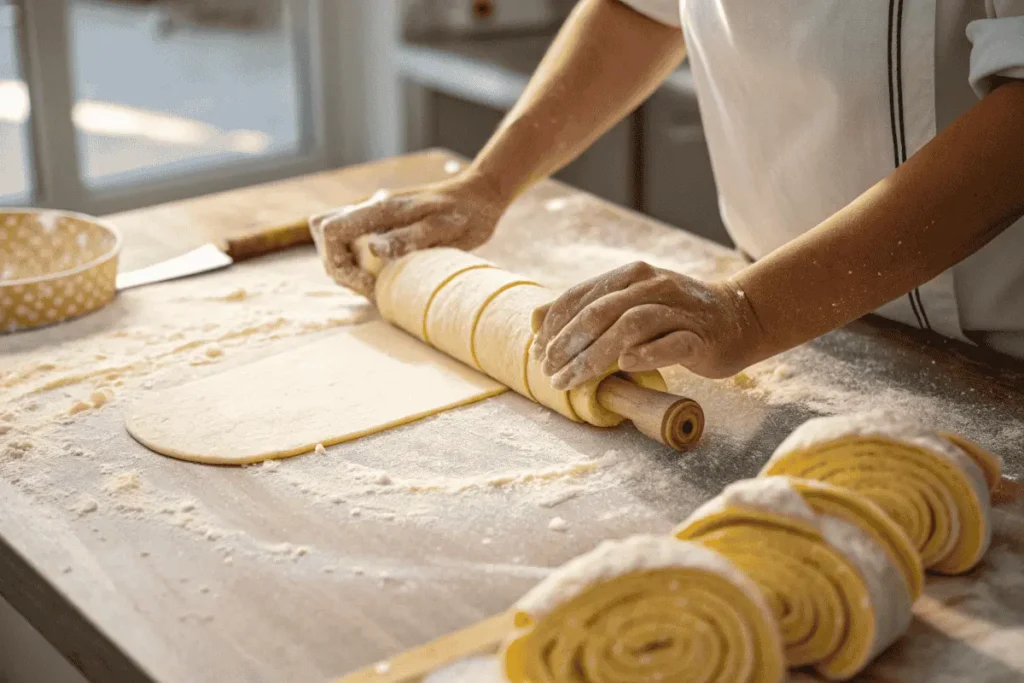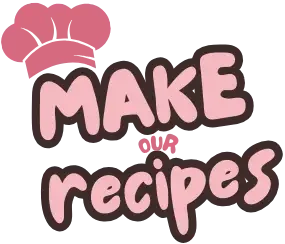There’s no denying the allure of a golden, flaky croissant—its buttery layers practically melt in your mouth. But creating the perfect croissant isn’t as simple as it looks. From improper ingredients to rushed lamination, there are many pitfalls that bakers face. So, what is a common mistake in croissants? This article breaks it down, step by step, covering everything from ingredient selection to baking techniques. Whether you’re a beginner or an experienced baker, this guide will help you avoid errors and master the art of croissant-making.
Introduction to Croissant Making
The Art of Making Perfect Croissants
Croissant-making is both an art and a science. It combines precision with creativity to produce a pastry that’s light, flaky, and bursting with flavor. Unlike quick recipes, croissants demand patience and skill. The process involves laminating dough with butter to create layers that puff up beautifully in the oven. But even a small mistake can lead to flat, dense, or greasy pastries. Understanding the intricacies of this process is the first step to success.
Why Do Common Mistakes Happen?
Baking croissants isn’t just about following a recipe—it’s about mastering techniques. Mistakes often arise when shortcuts are taken or key steps are misunderstood. For instance, rushing the proofing stage can prevent the dough from developing its signature rise. Similarly, using cold or low-quality butter can ruin the lamination process. Recognizing these errors helps bakers avoid them and achieve better results.
The Importance of Precision in Croissant Baking
Every step in croissant-making, from measuring ingredients to folding dough, requires precision. Small missteps, like overworking the dough or proofing it at the wrong temperature, can compromise the final product. Precision ensures that the layers remain intact and the pastry develops its characteristic flakiness. So, if you’ve been wondering, what is a common mistake in croissants, the answer often lies in a lack of attention to detail.
Common Mistakes When Making Croissants
Mistake 1: Using Incorrect Ingredients
One of the most frequent answers to what is a common mistake in croissants lies in ingredient selection. Many bakers opt for low-quality butter or all-purpose flour instead of bread flour. Bread flour has a higher protein content, which gives the dough the elasticity it needs for proper lamination. Similarly, using unsalted, high-fat European-style butter ensures smooth layers and enhances the croissant’s flavor.
Moreover, failing to measure ingredients precisely can lead to a dough that’s too sticky or too dry, making it harder to work with. Always weigh your ingredients with a kitchen scale to maintain accuracy.
Mistake 2: Skipping or Rushing the Lamination Process
Lamination is the heart of croissant-making, and cutting corners here can ruin the texture. The process involves folding butter into the dough to create layers, but many bakers rush it, leading to uneven layers or butter leakage during baking. If the butter isn’t cold enough or the dough isn’t rested between folds, you’ll end up with dense, flat pastries.
Mistake 3: Improper Proofing Techniques
Another common pitfall is neglecting proper proofing. Croissants need to proof in a warm, humid environment to rise correctly. Proofing at too high a temperature can cause the butter to melt prematurely, while underproofing results in croissants that don’t expand properly in the oven. Use a proofing box or let the dough rise in a draft-free spot.
Mistake 4: Baking at the Wrong Temperature
Temperature is everything when it comes to baking croissants. Baking them at too low a temperature prevents proper puffing, while an oven that’s too hot can burn the exterior before the layers cook through. To get that perfect golden-brown finish, preheat your oven to 375°F (190°C) and ensure even heat distribution.
Mistake 5: Overhandling the Dough
Croissant dough is delicate, and overworking it can destroy the gluten structure, leading to dense pastries. Always handle the dough with care, avoiding excessive kneading or folding beyond the recommended steps. This helps maintain the layers and ensures a light, flaky texture.
For more detailed tips, explore related baking articles like Common Mistakes in Baking Croissants.
Tips for Avoiding Croissant Baking Errors
Choosing High-Quality Ingredients
To create bakery-quality croissants, invest in the right ingredients. Look for unbleached bread flour and European-style butter with at least 82% fat content. The higher fat percentage ensures smooth, pliable layers that bake beautifully. Opt for fresh, active yeast to guarantee a proper rise.
Mastering the Lamination Process
Lamination may seem intimidating, but with patience and technique, you can nail it. Start with chilled butter and dough to maintain distinct layers. Roll out the dough evenly, ensuring no tears, and use light, consistent pressure when folding. Rest the dough in the fridge between folds to relax the gluten and keep the butter from melting.
Understanding Proofing Times and Techniques
Proper proofing is the key to airy croissants. After shaping, let the dough proof until it doubles in size—this usually takes 1.5 to 2 hours at 75°F (24°C). Cover the croissants with a damp cloth or plastic wrap to prevent drying.
Perfecting Oven Settings and Baking Timing
Always preheat your oven and bake croissants on the center rack for even heat. Use a baking stone if possible to maintain consistent temperature. Rotate the tray halfway through baking to ensure an even, golden crust. These small adjustments can make a huge difference in the final product.
Step-by-Step Guide to Making Perfect Croissants
Preparation: Measuring and Mixing the Dough
Begin by gathering your ingredients: bread flour, sugar, salt, yeast, milk, and butter. Precision is key, so use a kitchen scale for accuracy. In a mixing bowl, combine the dry ingredients, then gradually add the milk and yeast mixture. Knead the dough until it forms a smooth ball, ensuring it’s elastic but not sticky. Chill the dough in the refrigerator for at least 30 minutes to allow the gluten to relax.
Lamination: Folding Butter into the Dough

The lamination process is crucial to creating the signature layers in croissants. Roll out the chilled dough into a rectangle. Place a slab of cold butter in the center, then fold the dough over the butter like an envelope. Roll the dough into a long rectangle, then fold it into thirds. Repeat this process three times, chilling the dough for 30 minutes between each fold.
Carefully maintain even pressure while rolling to avoid tearing the layers. If you’ve wondered, what is a common mistake in croissants, uneven lamination is often the culprit.
Proofing: Allowing Dough to Rise Properly
After shaping the croissants, let them proof until they’ve doubled in size. This step is essential for achieving a light and airy texture. Place the shaped croissants in a warm, humid environment, like a proofing box or a draft-free spot covered with a damp cloth. Be patient—rushing this step can lead to flat, dense pastries.

Baking: Achieving a Golden, Flaky Finish
Preheat your oven to 375°F (190°C) and line a baking sheet with parchment paper. Brush the croissants with an egg wash to enhance their golden color. Bake for 15-20 minutes, rotating the tray halfway through for even browning. When done, your croissants should be golden, flaky, and irresistibly aromatic.
FAQs About Croissant Baking
Why Are My Croissants Not Rising Properly?
One of the most common questions is what is a common mistake in croissants that causes poor rising? The answer often lies in the yeast or proofing conditions. Ensure your yeast is fresh and active before mixing the dough. Additionally, proof croissants in a warm, humid environment to help the dough rise correctly.
What Causes Croissants to Be Dense Instead of Flaky?
Dense croissants are usually the result of improper lamination. If the butter isn’t evenly distributed or the dough is overworked, the layers won’t puff up during baking. Keep the butter cold and handle the dough gently to maintain its structure.
How Can I Avoid Butter Leaking During Baking?
Butter leakage occurs when the dough or butter becomes too warm. To prevent this, chill the dough thoroughly between folds and ensure the butter is pliable but not melted. A consistent rolling technique also helps keep the butter sealed within the layers.
What Is the Best Way to Store Leftover Croissants?
To maintain freshness, store baked croissants in an airtight container at room temperature for up to 2 days. For longer storage, freeze them in a sealed bag. Reheat frozen croissants in the oven at 350°F (175°C) for about 10 minutes for a freshly baked taste.
For additional baking tips, explore other helpful guides like Croissant Troubleshooting Tips.
Troubleshooting Common Croissant Problems
Why Do Croissants Lose Their Shape During Baking?
A frequent concern among bakers is what is a common mistake in croissants that leads to misshapen pastries. One major issue is inadequate chilling during the lamination process. If the dough or butter becomes too warm, the layers can shift, causing the croissants to lose their structure. Another potential culprit is uneven rolling, which creates inconsistent thicknesses in the dough.
To avoid this, ensure the dough is chilled between folds and roll it out evenly using a rolling pin with gentle pressure. Additionally, avoid stretching the dough when shaping the croissants, as this can distort their shape during proofing and baking.
Why Do Croissants End Up Too Greasy or Soggy?
Nobody wants a greasy or soggy croissant! This often happens when the butter melts too quickly during baking, saturating the dough rather than creating steam to puff up the layers. Overproofing the croissants can also lead to excessive butter leakage.
To fix this, preheat your oven properly and bake croissants on a high heat setting to allow the butter to create steam quickly. Avoid proofing for too long and ensure the butter is properly locked within the dough during lamination.
Why Croissants Are Worth the Effort
A Pastry That Rewards Precision
Although croissants require time and technique, the end result is undeniably worth the effort. These buttery, flaky pastries embody the perfect balance of crunch and softness. The joy of pulling apart those delicate layers makes the process deeply satisfying for bakers and eaters alike. By understanding what is a common mistake in croissants and learning how to avoid it, you’ll elevate your baking game and achieve consistent, professional-quality results.
Why Homemade Croissants Are Better
Store-bought croissants may be convenient, but they often lack the freshness and flavor of homemade ones. Baking croissants from scratch lets you control the quality of ingredients, ensuring a pastry that’s rich, buttery, and free of preservatives. Plus, homemade croissants can be customized with fillings like chocolate, almond paste, or savory options like cheese and ham.
Homemade croissants also create a sense of accomplishment that no store-bought pastry can match. Whether you’re making them for a special occasion or as a weekend project, the experience is as rewarding as the finished product.
For more baking inspiration, explore other guides on croissants and pastries like Mastering Artisan Baking.
Tips for Perfecting Your Croissants
Plan Your Time and Tools
Success with croissants often comes down to preparation. Plan your schedule to allow enough time for chilling, laminating, and proofing. Each step requires patience and precision, so avoid rushing. Equip yourself with the right tools: a rolling pin for even dough thickness, a pastry brush for egg washes, and a bench scraper for clean cuts and easy handling.
Planning also includes understanding what is a common mistake in croissants. For example, one overlooked error is failing to let the dough rest. Resting helps relax the gluten, making the dough easier to work with and ensuring those iconic layers remain intact.
Practice Makes Perfect
Croissant-making is a skill that improves with practice. Your first batch might not look like it came from a Parisian bakery, but each attempt will teach you something new. Focus on mastering the lamination process, as this is where most bakers stumble. Pay attention to temperature control and dough handling, and don’t hesitate to troubleshoot issues like butter leakage or uneven baking.
To build confidence, start with smaller batches or try variations like mini croissants. Once you’ve perfected the basics, you can experiment with creative fillings and shapes, adding your unique twist to this classic pastry.
Conclusion and Why Mastering Croissants Matters
Why Understanding Mistakes Is Key
Learning what is a common mistake in croissants not only prevents baking disasters but also deepens your appreciation for this iconic pastry. Croissants are more than just a breakfast staple; they’re a testament to the artistry and precision of baking. By identifying and avoiding common errors, you’ll be well on your way to creating pastries that rival those from a professional bakery.
The Reward of Homemade Croissants
Few things in baking are as satisfying as pulling a tray of freshly baked croissants out of the oven. The golden crust, the flaky layers, and the rich aroma make all the effort worthwhile. Mastering croissants isn’t just about the final product—it’s about embracing the process and the joy of learning something new.
Whether you’re a beginner or an experienced baker, understanding and avoiding mistakes allows you to craft croissants with confidence. Each successful bake builds your skills and sets you up for even greater accomplishments in the kitchen.
For more advanced techniques and delicious recipes, don’t forget to explore guides like How to Perfect Croissant Dough. Happy baking!
Storing Your Croissants
Knowing the best way to store your croissants helps keep them fresh. Therefore, proper storage maintains their texture and flavor. Specifically, you can enjoy them later as if they were freshly baked. Additionally, with these storage tips, your croissants will stay amazing for a longer period of time.
Storage Tips
- Store in an airtight container.
- Consume within a day for best results.
- Freeze for longer storage.
- You can also reheat them in an oven.
The Joy of Making Croissants
Baking croissants at home can be a very rewarding experience. Therefore, do not be discouraged if you experience some issues. Specifically, every mistake is a chance to improve. Consequently, you will become more skillful over time. Additionally, enjoy the process of learning and making these delicious pastries. Moreover, every bake will make you better.
Enjoy the Process
- Embrace the challenges.
- Learn from your mistakes.
- Celebrate your successes.
- Baking is a great way to unwind.
- The satisfying feeling of making something from scratch.
Frequently Asked Questions (FAQs)
What makes croissants flaky?
The flakiness of croissants comes from the process of lamination. This involves layering butter and dough, creating thin layers that separate while baking. It’s crucial to keep the butter cold to achieve this.
Why are my croissants not rising?
If your croissants are not rising, they were most likely under-proofed. Make sure to proof them in a warm, humid environment until they are puffy and soft. The temperature of your proofing area can also play a major role.
What kind of flour is best for croissants?
High-protein flour, like bread flour, is best for making croissants. It helps develop the gluten and provides the structure needed for a flaky and airy result. The right flour is key for great results.
Why is my croissant dough sticky?
Your croissant dough might be sticky because of the humidity or because you have overworked the dough. Keep your dough cold and work in a cool place to keep the butter from melting. Avoid over-kneading to prevent stickiness.

